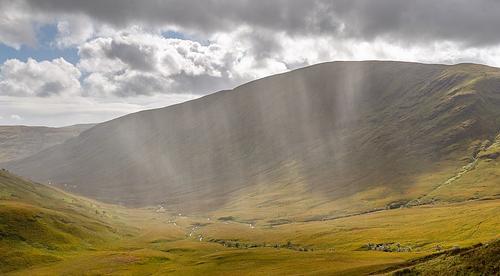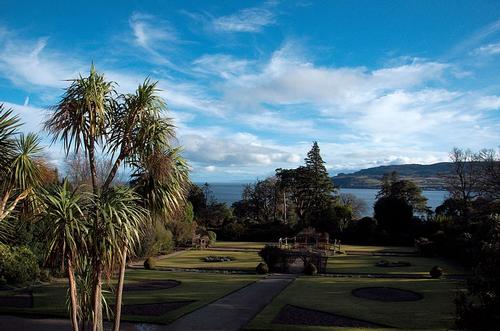SCOTLAND
Climate and Weather

Climate and Weather
Cities in SCOTLAND
| Edinburgh | Glasgow |
Popular destinations UNITED KINGDOM
| England | Northern ireland | Scotland |
| Wales |
Climate and Weather
 Rain over Beinn Eich, Luss Hills, ScotlandPhoto: Michal Klajban CC 4.0 International no changes made
Rain over Beinn Eich, Luss Hills, ScotlandPhoto: Michal Klajban CC 4.0 International no changes made
Due to the direction in which the Scottish mountains lie, the climate, in addition to the strong southwestern winds, is strongly influenced by the Atlantic Ocean. In winter, this ensures relatively mild temperatures in the lower parts. It gets colder in winter on the high plains, in the mountains and on the northern coasts. In January, the average temperature is between 3-5 °C and freezing at night, and the higher mountains remain covered with snow for months. Summers are generally quite cool: the average temperature in the month of July is 13-15 °C, but in the afternoon it often rises above 20 °C. It rarely gets warmer than 24 °C.
Most of the rain falls in the western mountainous regions, where the southwesterly winds carry very moist air from the Atlantic Ocean. The average falls around 2500 mm per year.Particularly the Outer Hebrides or "Western Isles" are often plagued by depressions with gale force winds and numerous rain showers. On the east coast it rains considerably less, especially in the months of May and June. It is remarkable that the capital Edinburgh has less rain every year than De Bilt (676 mm against 763 mm). The wettest months are July through November, and January is also usually wet.
 The gardens at Brodick Castle, Isle of Arran, ScotlandPhoto: Magnus Hagdorn CC 2.0 Generic no changes made
The gardens at Brodick Castle, Isle of Arran, ScotlandPhoto: Magnus Hagdorn CC 2.0 Generic no changes made
Located west of the Isle of Mull in the open Atlantic Ocean, Coll and Tiree are known as Britain's sunniest islands. All kinds of differences can also occur on one island. For example, in the western part of Rhum, one of the islands of the Inner Hebrides, there is an average of 110 mm of rainfall every month, while in Kinloch, just 8 kilometers to the east, it falls as much as 230 mm per year. Due to the gulf current, the climate of the island of Arran is quite mild and even palm trees grow here and there.
Sources
Berkien, G. / Schotland
Kosmos-Z&K
Berkien, G. / Schotland
ANWB
Larrimore, D. / Schotland
Kosmos-Z&K
Levy, P. / Scotland
Marshall Cavendish
Patitz, A. / Schotland
Van Reemst
Schaff, B. / Schotland
Kok Lyra
Schotland
Cambium
Schotland
Lannoo
Schotland
Michelin Reisuitgaven
Schotland
Van Reemst
Smallman, T. / Scotland
Lonely Planet
Stoks, F.T. / Schotland
Gottmer
Summers, G. / Schotland
Van Reemst
Tschirner, S. / Schotland
ANWB
Wamel, D. van / Schotland en Noord-Engeland
Babylon-De Geus
CIA - World Factbook
BBC - Country Profiles
Last updated November 2025Copyright: Team The World of Info